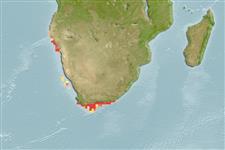Teleostei (teleosts) >
Eupercaria/misc (Various families in series Eupercaria) >
Sciaenidae (Drums or croakers)
Etymology: Argyrosomus: Greek, argyros = silvered, silver + Greek, soma = body (Ref. 45335); inodorus: Name from the Latin 'inodorus' meaning without smell (first suspected of being a different species because it lacked the strong brassy/metallic smell that is typical of A. japonicus found in South African waters..
Environment: milieu / climate zone / depth range / distribution range
Ecology
Marine; brackish; benthopelagic; oceanodromous (Ref. 51243); depth range 1 - 100 m (Ref. 11025). Subtropical; 17°S - 38°S, 11°E - 29°E
Southeast Atlantic: Namibia southwards around the Cape of Good Hope and northwards at least as far as the Kei River in South Africa.
Length at first maturity / Size / Weight / Age
Maturity: Lm 34.4 range ? - ? cm
Max length : 145 cm TL male/unsexed; (Ref. 11025); common length : 115 cm TL male/unsexed; (Ref. 11025); max. published weight: 36.3 kg (Ref. 11025)
Short description
Morphology | Morphometrics
Dorsal
spines
(total): 11;
Dorsal
soft rays
(total): 25-29;
Anal
spines: 2;
Anal
soft rays: 7 - 8;
Vertebrae: 25. Swim bladder carrot-shaped with 31-42 arborescent appendages, the latero-anterior limb of appendages present throughout length of bladder; drumming muscles present only in males; urinary bladders rudimentary; sagitta elongate with pronounced bulge in posterior third of ventral margin; pectoral fin axillary fold naked; peritoneum unpigmented; anterior part of lateral line slightly curved.
Between the Kei River and Cape Agulhas, this species rarely enters estuaries or the surf zone, but becomes more abundant in the surf zone on the west coast of South Africa. Restricted to a depth of 1-20 m in Namibia, apparently due to anoxic conditions beyond this depth. Highly regarded as a table fish. Marketed mostly fresh, but sometimes frozen (Ref. 11025).
Life cycle and mating behavior
Maturity | Reproduction | Spawning | Eggs | Fecundity | Larvae
Griffiths, M.H. and P.C. Heemstra, 1995. A contribution to the taxonomy of the marine fish genus Argyrosomus (Perciformes: Sciaenidae), with descriptions of two new species from southern Africa. Ichthyol. Bull., J.L.B. Smith Inst. Ichthyol. No. 65, 40 p. (Ref. 11025)
IUCN Red List Status (Ref. 130435)
Threat to humans
Harmless
Human uses
Fisheries: commercial; gamefish: yes
More information
ReferencesAquacultureAquaculture profileStrainsGeneticsElectrophoresesHeritabilityDiseasesProcessingNutrientsMass conversion
Tools
Special reports
Download XML
Internet sources
Estimates based on models
Preferred temperature (Ref.
123201): 13.9 - 21.7, mean 16.3 °C (based on 48 cells).
Phylogenetic diversity index (Ref.
82804): PD
50 = 0.5020 [Uniqueness, from 0.5 = low to 2.0 = high].
Bayesian length-weight: a=0.00813 (0.00477 - 0.01384), b=3.07 (2.93 - 3.21), in cm total length, based on LWR estimates for this species & (Sub)family-body (Ref.
93245).
Trophic level (Ref.
69278): 4.2 ±0.67 se; based on food items.
Resilience (Ref.
120179): Medium, minimum population doubling time 1.4 - 4.4 years (K=0.09-0.12; tm=1.3-2.4).
Prior r = 0.35, 95% CL = 0.23 - 0.52, Based on 2 stock assessments.
Fishing Vulnerability (Ref.
59153): High to very high vulnerability (68 of 100).
Nutrients (Ref.
124155): Calcium = 23.8 [8.7, 62.9] mg/100g; Iron = 0.459 [0.153, 1.330] mg/100g; Protein = 19.3 [17.3, 21.3] %; Omega3 = 0.299 [0.157, 0.522] g/100g; Selenium = 23.4 [7.6, 89.8] μg/100g; VitaminA = 17.9 [5.6, 58.4] μg/100g; Zinc = 0.592 [0.424, 0.858] mg/100g (wet weight);
